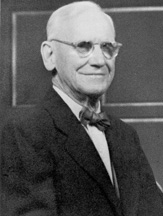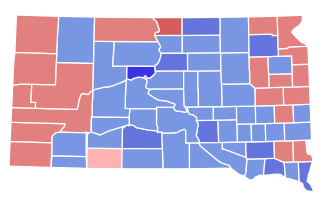Related Research Articles

William Henry McMaster was an American politician who served as the tenth Governor of South Dakota from 1921 until 1925. A member of the Republican Party,he went on to serve as a member of the United States Senate from South Dakota from 1925 to 1931.

Harlan John Bushfield was an American politician from South Dakota. He served as the 16th governor of South Dakota and as a United States senator.

Sigurd Anderson was the 19th Governor of South Dakota. Anderson,a Republican from Webster,South Dakota,served in that office from 1951 to 1955.

Harvey Lowell Wollman was an American politician who served as the 26th Governor of South Dakota from 1978 to 1979. He was the first Lieutenant Governor in the history of South Dakota to succeed to the governorship. To date,he is the last Democrat to serve as South Dakota's governor.
Lambert Anthony Hoch was an American prelate of the Roman Catholic Church. He served as Bishop of Bismarck (1952–1956) and Bishop of Sioux Falls (1956–1978).

The 1948 United States Senate election in South Dakota took place on November 2,1948. Incumbent Republican Senator Harlan J. Bushfield,suffering from poor health,declined to run for re-election. On September 27,1948,he died in office;his wife,Vera C. Bushfield,was appointed to succeed him. Congressman Karl E. Mundt easily won the Republican primary and advanced to the general election,where he was opposed by Democratic nominee John A. Engel,an attorney. Hundt defeated Engel in a landslide.

The 1932 United States Senate election in South Dakota took place on November 8,1932. Incumbent Republican Senator Peter Norbeck ran for re-election to a third term. After easily turning back a challenge from former State Senator Harry F. Brownell in the Republican primary,Norbeck faced attorney Ulysses Simpson Grant Cherry,the Democratic nominee,in the general election. Owing in part to Franklin D. Roosevelt's landslide victory in South Dakota,the race was much closer than it was in 1926,but Norbeck still defeated Cherry by a decisive margin to win his third,and final,term. Norbeck died in office on December 20,1936,triggering a special election in 1938.

The 1906 South Dakota gubernatorial election was held on November 6,1906. Incumbent Republican Governor Samuel H. Elrod ran for re-election,but was defeated for renomination at the Republican convention by former Attorney General Coe I. Crawford. In the general election,Crawford was opposed by the Democratic nominee,former State Representative John A. Stransky of Brule County. Crawford had little difficulty defeating Stransky in a landslide,largely matching Elrod's margin of victory from two years earlier.

The 1920 United States Senate election in South Dakota took place on November 2,1920. Incumbent Democratic Senator Edwin S. Johnson declined to seek re-election to a second term. In the Democratic primary,attorney Ulysses Simpson Grant Cherry defeated former State Senator Louis Napoleon Crill and former U.S. Marshal Tom Taubman,while in the Republican primary,Governor Peter Norbeck defeated former State Supreme Court Justice Dick Haney. In the general election,Cherry and Norbeck faced a litany of independent candidates,including Nonpartisan League candidate Tom Ayres. Benefiting from the split in left-wing candidates,Norbeck won by a wide margin,with Ayres narrowly beating out Cherry for second place.

Gordon James Mydland was an American attorney and politician who served as the Attorney General of South Dakota. He was also a state senator,and a circuit court judge.
Kermit A. Sande is an American politician and attorney in the state of South Dakota. He served as Attorney General of South Dakota from 1973 to 1975,as a Democrat.

The 1962 United States Senate election in South Dakota took place on November 6,1962. Incumbent Republican Senator Francis H. Case ran for re-election to a third term. He won the Republican primary against Attorney General A. C. Miller,but shortly after the primary,died. The Republican State Central Committee named Lieutenant Governor Joseph H. Bottum as Case's replacement on the ballot,and Governor Archie Gubbrud appointed Bottum to fill the vacancy caused by Case's death. In the general election,Bottum was opposed by Democratic nominee George McGovern,the Director of Food for Peace and the former U.S. Congressman from South Dakota's 1st congressional district. The contest between Bottum and McGovern was quite close,with McGovern narrowly defeating him for election by just 597 votes,making him the first Democrat to win a Senate election in South Dakota since William J. Bulow's win in 1936.

Clarence C. Caldwell was an American attorney and the 9th Attorney General of South Dakota.

John L. Pyle was an attorney and politician from the state of South Dakota. A Republican,he was notable for his service as State's Attorney of Hand County (1886-1888) and state Attorney General (1899-1902).

The 1950 South Dakota gubernatorial election was held on November 7,1950. Incumbent Republican Governor George T. Mickelson was unable to seek re-election to a third term due to newly imposed term limits. Accordingly,a competitive race to replace him ensued. Attorney General Sigurd Anderson won a slim plurality in the Republican primary,barely exceeding 35% and narrowly avoiding having the Republican nomination sent to the state party convention. In the general election,Anderson faced State Representative Joe Robbie. Anderson easily defeated Robbie,winning his first term with 61% of the vote to Robbie's 39%.

The 1928 South Dakota gubernatorial election was held on November 6,1928. Incumbent Democratic Governor William J. Bulow ran for re-election to a second term. In the general election,he faced Attorney General Buell F. Jones,the Republican nominee. Despite Republican presidential nominee Herbert Hoover overwhelmingly defeating Democratic nominee Al Smith overwhelmingly in South Dakota,Bulow defeated Jones by a decisive margin to retain the governorship. In so doing,he became the first Democratic candidate for Governor to receive a majority of the vote in the state's history.

The 1932 South Dakota gubernatorial election was held on November 8,1932. Incumbent Republican Governor Warren Green ran for re-election to a second term. He defeated former Governor Carl Gunderson in the Republican primary and faced former State Representative Tom Berry,the Democratic nominee,in the general election. Aided by Democratic presidential nominee Franklin D. Roosevelt's landslide victory in South Dakota,Berry defeated Green for re-election in a landslide.

The 1940 South Dakota gubernatorial election was held on November 5,1940. Incumbent Republican Governor Harlan J. Bushfield sought re-election to a second term. After winning the Republican primary by a large margin,he faced Democrat Lewis W. Bicknell,former Day County State's Attorney,in the general election. Though Bushfield underperformed Republican presidential nominee Wendell Willkie,who won the state in a landslide,he nonetheless defeated Bicknell by a wide margin to easily win re-election.

The 1942 South Dakota gubernatorial election was held on November 3,1942. Incumbent Republican Governor Harlan J. Bushfield declined to seek re-election to a third term and instead successfully ran for the U.S. Senate. A crowded Republican primary developed to succeed him,and because no candidate received 35% of the vote,the nomination was decided at the state Republican convention,where former Attorney General Merrell Q. Sharpe,the second-place finisher in the primary,won the nomination. In the general election,Sharpe faced Democratic nominee Lewis W. Bicknell,the 1940 Democratic nominee for governor. Aided by the national Republican landslide,Sharpe defeated Bicknell in a landslide.

Donald E. Osheim was an American politician. He served as a Republican member of the South Dakota House of Representatives.
References
- ↑ Barnett, Steven J. (2019). "Legislative Manual: South Dakota 2019" (PDF). Office of the South Dakota Secretary of State. p. 158. Archived (PDF) from the original on 2020-10-18. Retrieved May 13, 2020.
- 1 2 South Dakota Legislative Manual, 1933, page 507
- ↑ "Political Graveyard" . Retrieved May 13, 2020.
- ↑ South Dakota Legislative Manual, 1935, page 545
- ↑ South Dakota Legislative Manual, 1933, page 309
- ↑ South Dakota Legislative Manual, 1935, page 337
